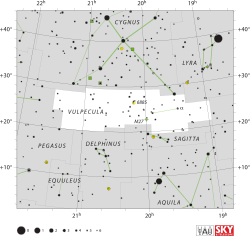Talk:V Sagittae
| This is the talk page for discussing improvements to the V Sagittae article. This is not a forum for general discussion of the article's subject. |
Article policies
|
| Find sources: Google (books · news · scholar · free images · WP refs) · FENS · JSTOR · TWL |
| This article is rated Start-class on Wikipedia's content assessment scale. It is of interest to the following WikiProjects: | ||||||||||||||
| ||||||||||||||
Put coming nova in context by basing on Vulpecula_IAU.svg image[edit]

Since V Sge is in the far upper-left of Sagitta, the current Location mark image, based on the existing Sagitta constellation image, puts the target circle off-center. It would be much easier for the average user to get a sense of context, see stars of similar brightness to the eventual nova, notice the spot near the center of the image, and find the right area of the sky if the image included the Summer Triangle stars. E.g. it could be based on https://en.wikipedia.org/wiki/Vulpecula#/media/File:Vulpecula_IAU.svg as shown above, or on a relatively simple modification of that image with an all-white background. ★NealMcB★ (talk) 03:20, 10 January 2020 (UTC)
- This is also similar to how the researchers presented their info in a press conference. See [1] via [2] and [3]. ★NealMcB★ (talk) 17:04, 10 January 2020 (UTC)
@Nealmcb: The IAU maps are terrible to view at a thumbnail level, though, which is how they'll be presented in {{Starbox image}}. Note how things are a lot more discernable on Torsten Bronger's map (left) compared to the IAU map (right) when viewed at thumbnail width? – PhilipTerryGraham (talk · articles · reviews) 00:08, 11 January 2020 (UTC)
Doubling time?[edit]
Article says, “The doubling time is about 89 years.” Doubling time of what? Mass transfer? How is this related to the doubling time of brightness, about 30 years (based on 10x over a century)? And how does this gradual brightening relate, if at all, to the increase in the final weeks or months, as the wording seems to suggest? Jmacwiki (talk) 04:50, 3 October 2021 (UTC)
- Clarified. I also added a new reference, although I couldn't find a formal publication for this paper. Lithopsian (talk) 15:33, 3 October 2021 (UTC)




